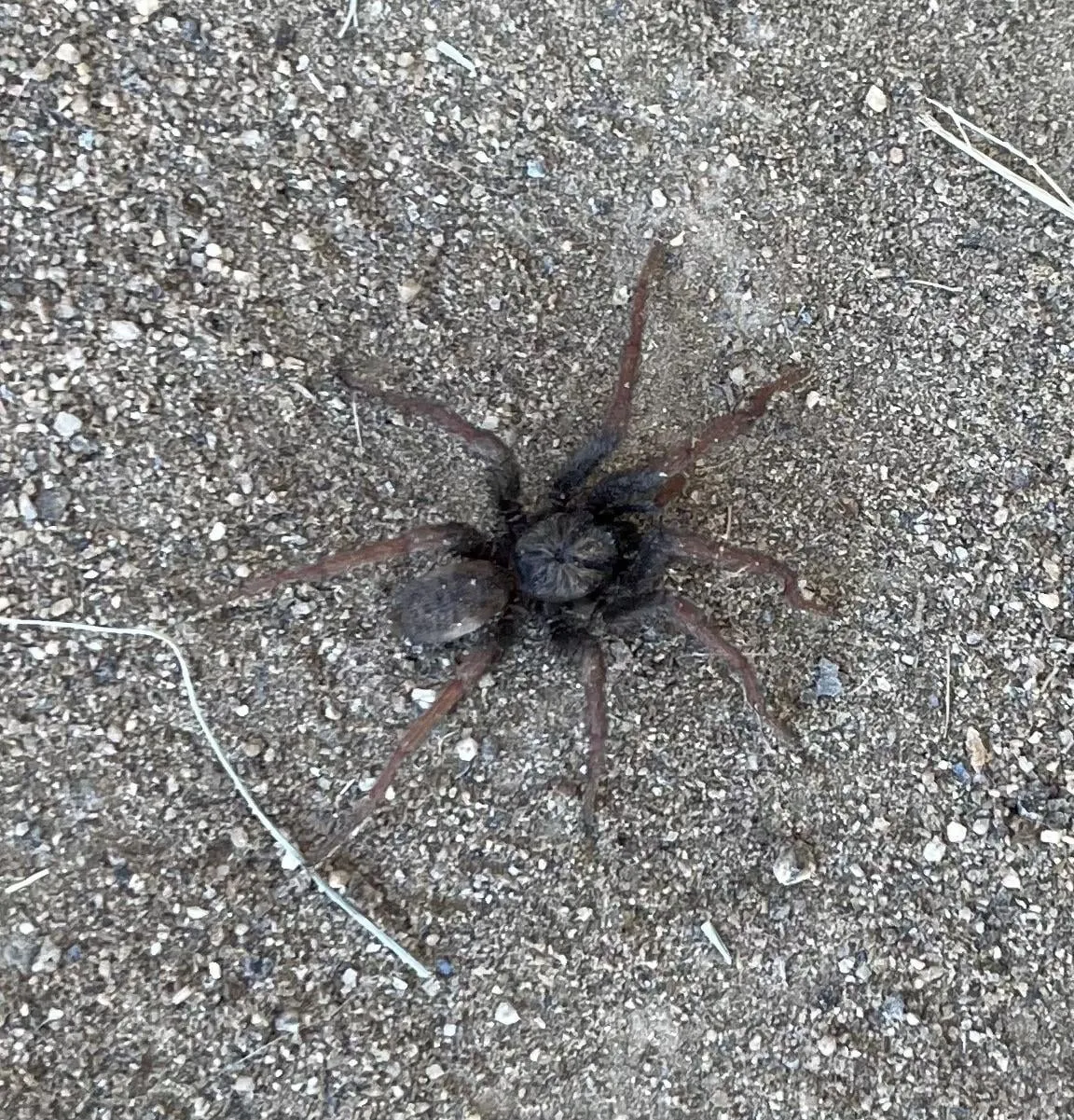What are California Tarantulas
California tarantulas are large, hairy spiders belonging to the Theraphosidae family. These impressive arachnids are a common sight in many parts of California, and they are a vital part of the ecosystem. Despite their intimidating appearance, they are generally not considered dangerous to humans, and their presence is often a sign of a healthy environment. They play a significant role in controlling insect populations, making them beneficial to the local environment. The tarantula spiders are a fascinating subject of study, and there’s much to discover about their lives and behaviors in the wild. Understanding their role in the ecosystem helps us appreciate these creatures and their importance to the Californian landscape. Their size and distinct features make them easily recognizable, and their behaviors are a source of endless curiosity for both scientists and nature enthusiasts alike.
Identifying California Tarantulas
Appearance

California tarantulas are easily recognizable due to their large size and hairy appearance. They have eight legs, two body segments (cephalothorax and abdomen), and two pedipalps near their mouth used for manipulating food. Their coloration can vary, but they are often brown or black, sometimes with reddish or orange hairs. These spiders have powerful fangs for capturing prey and spinnerets at the end of their abdomen for producing silk. They have a robust build, which helps them hunt and defend themselves. Their hairy bodies are not just for show; they also help with sensory input, aiding in detecting vibrations and air movements, crucial for hunting and avoiding predators. The contrast between their dark bodies and the lighter hairs can be quite striking, especially when they are seen up close.
Size and Lifespan
Female California tarantulas are typically larger than males, with a leg span that can reach up to 6 inches or more. Males are often smaller, particularly during their final molt. The lifespan of these spiders is also quite different between the sexes. Females can live for up to 25 years, while males have a much shorter lifespan, often living only a few years after reaching maturity. This difference in lifespan is a fascinating aspect of their biology, influenced by their different roles in reproduction. The size and longevity make California tarantulas a remarkable example of the arachnid world. Understanding their size and lifespan gives a better appreciation of their place in the ecosystem and the unique strategies they employ to survive and thrive.
Habitat
California tarantulas are found in a variety of habitats, including grasslands, chaparral, and oak woodlands. They prefer to live in burrows, which they dig in the ground or occupy abandoned rodent burrows. These burrows provide shelter from the sun, predators, and extreme weather conditions. The spider’s choice of habitat is heavily influenced by the availability of food and suitable ground for burrowing. They are most active during the warmer months, often emerging from their burrows to hunt or mate. The habitats they prefer generally offer plenty of insects and other small creatures for them to prey on. Observing their habitat preferences can reveal much about their behavior and ecological roles. The ability of tarantulas to adapt and thrive in various Californian environments is truly remarkable.
Where to Find California Tarantulas

Tarantulas are found across California. They are most active during the mating season, typically in the fall, when males wander in search of females. The best places to spot them are in areas with suitable habitats, such as grasslands and hillsides. They are often found near their burrows, which can be identified by the silk webbing around the entrance. During the mating season, males are more likely to be seen crossing roads and trails in search of mates. Careful observation during the right time of year will increase the chances of spotting a California tarantula in its natural environment. Always observe them from a safe distance, respecting their space and natural behaviors. Knowing where to look can turn a simple hike into an exciting opportunity to witness the natural wonders of California.
Behavior and Diet
Hunting and Feeding Habits
California tarantulas are primarily nocturnal hunters, meaning they are most active at night. Their diet consists mainly of insects, but they are also known to prey on small lizards, rodents, and other spiders. They are ambush predators, waiting patiently near their burrows for prey to pass by. When a suitable meal comes within reach, the tarantula will pounce, injecting venom through its fangs to immobilize and begin the digestion process. Their powerful fangs and venom are highly effective in subduing their prey. The tarantula’s hunting strategy is a testament to their efficiency in the ecosystem. They are patient hunters, and their success depends on their ability to blend with their surroundings and strike at the right moment, showcasing their natural adaptation for survival.
Top 5 Amazing Facts About California Tarantulas

Fact 1 Unique Venom
Tarantula venom is complex and primarily used to subdue prey, but it’s not considered highly dangerous to humans. The venom contains a mix of toxins that affect the nervous system of their prey. While a tarantula bite can be painful and cause localized symptoms, such as redness and swelling, it’s rarely life-threatening to humans. This specialized venom is a crucial component of their hunting arsenal, enabling them to paralyze and digest their meals. The study of tarantula venom is also of scientific interest, with researchers exploring its potential in medical applications. Understanding the composition and effects of the venom helps in better appreciating the tarantula’s role in the ecosystem and the complexity of its biological adaptations.
Fact 2 Molting Process
Tarantulas, like all spiders, molt, shedding their exoskeleton as they grow. This process, called ecdysis, allows the spider to increase in size. During molting, the tarantula becomes vulnerable, as its new exoskeleton is soft and delicate. The spider typically finds a safe place to molt, often on its back, and carefully wriggles out of its old exoskeleton. The molting process can take several hours, during which the spider is highly vulnerable to predators. Afterward, the new exoskeleton hardens, and the tarantula continues its life cycle. This fascinating process is essential for their growth and development, allowing them to shed old structures and renew themselves. It also provides a fascinating glimpse into their biology and adaptation to their environment.
Fact 3 Defensive Hairs

Tarantulas have specialized hairs called urticating hairs on their abdomen, which they use for defense. When threatened, they can flick these hairs towards predators, causing irritation and discomfort. The hairs are barbed and can embed themselves in the skin or eyes of the attacker, creating a defensive barrier. This unique defense mechanism helps protect them from being eaten by other animals. These hairs are a crucial part of their survival strategy, and they highlight the complexity of their defensive adaptations. The urticating hairs serve as a warning to potential threats. This ingenious defense system helps the tarantula thrive in its natural environment by ensuring a higher chance of survival. Always admire these creatures from a safe distance.
Fact 4 Mating Rituals
The mating rituals of California tarantulas are fascinating. During mating season, male tarantulas leave their burrows in search of females. The male will use his pedipalps to transfer sperm to the female. The males face several challenges, including avoiding being eaten by the female after mating. If successful, the female will lay eggs in a silk sac, which she protects. These complex rituals are a testament to the survival instinct and the continuation of their species. This mating behavior is a critical part of their life cycle, ensuring that new generations of tarantulas will continue to populate their habitat. The challenges and strategies involved in the mating process highlight the fascinating aspects of tarantula biology and social dynamics.
Fact 5 Common Species
Several species of tarantulas can be found in California, the most common being the California ebony tarantula (Aphonopelma eutylenum). Each species has unique characteristics, but they share many common traits, such as their size, hairy appearance, and preference for burrowing. While the California ebony tarantula is the most frequently encountered, other varieties may occasionally be observed in different parts of the state. These different species can vary in coloration and behavior, providing a diverse range of arachnid life to explore in California. Understanding these species allows for a deeper appreciation of the biodiversity within the California tarantula population. These species play vital roles within their respective ecosystems, highlighting the intricate balance of nature.
Conservation and Human Interaction

Threats to Tarantulas
California tarantulas face several threats, including habitat loss, pesticide use, and the pet trade. As human development expands, their natural habitats are being destroyed, reducing their available living spaces. Pesticides used in agriculture can also harm tarantulas, either directly or indirectly through the reduction of their prey. In addition, the collection of tarantulas for the pet trade can impact wild populations. It’s essential to be aware of these threats and take steps to protect these amazing creatures. Conservation efforts, habitat preservation, and responsible pet ownership are vital for the survival of these spiders. Protecting their habitats and promoting responsible interactions with tarantulas are critical actions for their long-term well-being.
What to Do if You Encounter a Tarantula
If you encounter a California tarantula, the best approach is to observe it from a safe distance. Avoid handling or trying to catch the spider, as this could lead to a bite. If you find a tarantula in your home, you can gently encourage it to leave by opening a door or window. It’s also important to respect their space and avoid disrupting their burrows or habitat. Should you find one, keep a safe distance and watch. This respects the spider and protects you from potential harm. Understanding and appreciating these creatures from a distance is a great way to learn and appreciate the natural world. Education and respect are the keys to a harmonious co-existence with these magnificent creatures.
Conclusion

California tarantulas are remarkable creatures that play a vital role in the state’s ecosystem. From their unique venom to their complex mating rituals, these spiders offer a wealth of fascinating facts. By understanding their behavior, habitat, and the threats they face, we can appreciate the importance of conserving these incredible animals. They are an essential part of the Californian landscape, and their presence is a sign of a thriving ecosystem. Further exploration and respect of their habitat will help ensure their survival for generations to come. Protecting tarantulas is a crucial part of preserving California’s natural heritage, guaranteeing that future generations can experience the wonders of these amazing arachnids. Embrace the opportunity to learn and admire these creatures from a safe distance.
